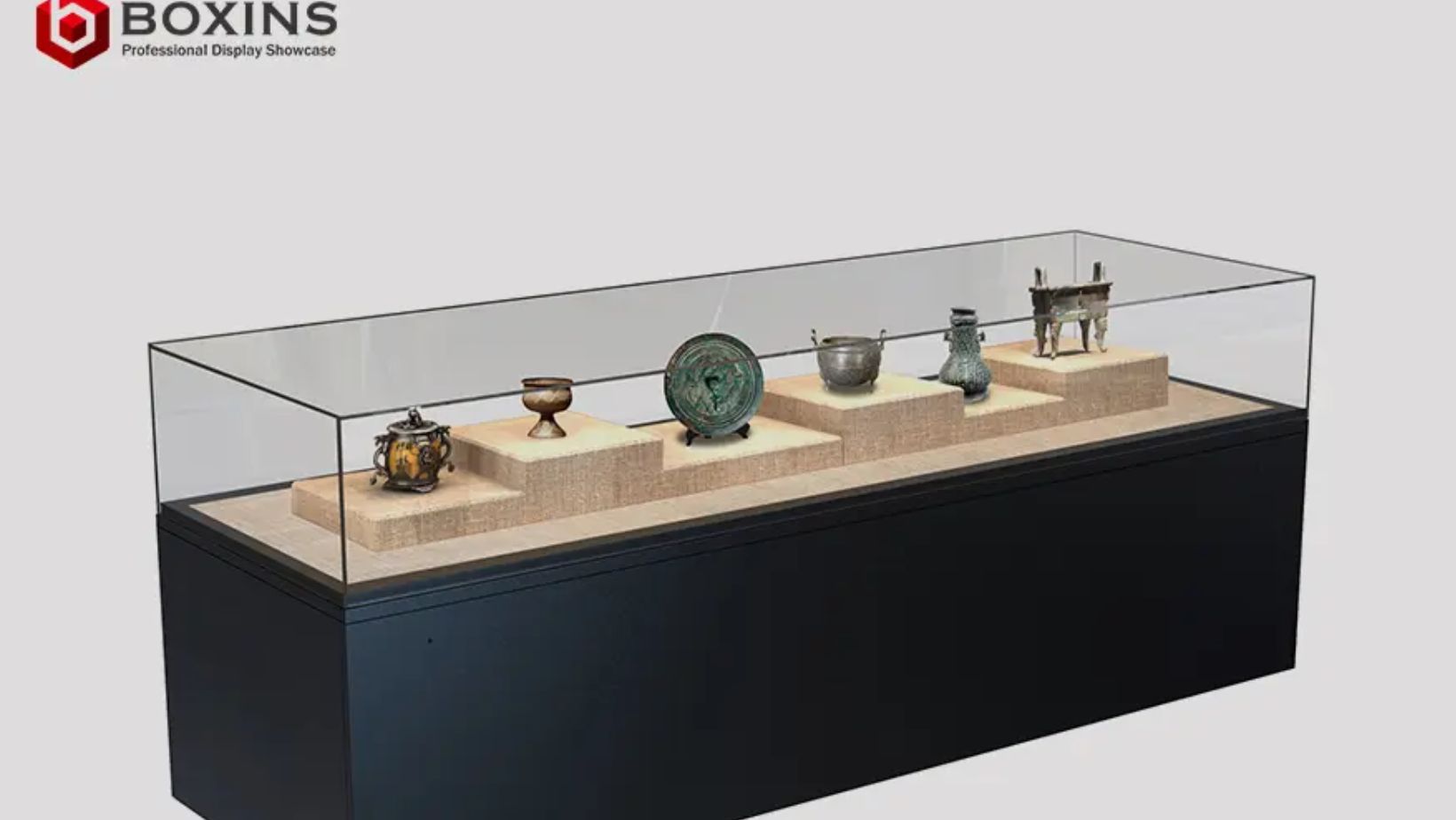Museums are vital in keeping our cultural heritage safe. A skilled museum showcase supplier is essential for this task. They create advanced display cases that protect valuable artifacts and engage visitors.
Today’s museum showcase suppliers do more than just protect items. They design systems that keep artifacts safe, control the environment, and make them visually appealing. This ensures that each piece is showcased perfectly.
These display cases have two main roles. They protect fragile artifacts from damage and offer visitors a deep learning experience. With modern designs and materials, each case becomes a window into history.
Working together, museums and showcase suppliers turn exhibitions into interactive learning spaces. They use new technologies and design strategies to share stories and preserve cultural treasures.
Table of Contents
ToggleUnderstanding the Role of Professional Museum Showcase Suppliers
A professional museum showcase supplier is key in keeping cultural heritage safe. They create custom display cases for museums and cultural spots. These cases are made to fit each place’s special needs.
Making big display cases needs a deep understanding of keeping things safe and making them interesting for visitors. The best suppliers work with museum curators. Together, they make showcases that keep artifacts safe and let visitors enjoy them.
Designing museum displays is a complex job that needs advanced engineering and science. Suppliers must think about things like keeping the environment stable, protecting against light, and making sure fragile items are safe. They sell large display cases to museums and cultural places.
Thanks to new technology, these experts can make showcases with exact control over the environment. They use special glass, control the climate inside, and protect against UV rays. These features are common in today’s museum displays.
Museums need these suppliers to show their collections to the public while keeping them safe. Suppliers use their knowledge and creativity to make sure historical items are protected. At the same time, they make sure visitors can enjoy and learn from these items.
The partnership between museums and showcase suppliers is very important for keeping cultural heritage alive. They work together to keep historical items safe and teach the public about them. This partnership helps museums keep their collections in top shape and educate visitors.
Essential Features of Modern Museum Display Cases
Modern museum display cases have changed how we keep and show artifacts. These advanced showcases protect delicate items while making visits more engaging. They are key in museums and art galleries.
At the heart of these cases are their protective features. UV-resistant glass keeps artifacts safe from harmful light. This stops colors from fading and materials from breaking down, helping preserve sensitive items.
Climate control is another big step forward. These cases have systems to control humidity and temperature. They create the perfect environment for fragile items, keeping them safe from changes in the air.
Today’s cases also have anti-reflective glass. This reduces glare and makes it easier to see the details of artifacts. They are designed to be changed easily, helping museums keep their displays fresh and interesting.
Safety is a top priority in making these cases. They are built strong and have security features to protect valuable items. Now, museums and galleries can show off rare artifacts safely and beautifully.
Advanced Material Technology in Museum Showcase Design
Modern museum showcase suppliers are changing how we keep artifacts safe. They use new glass and composite materials. These materials make displays clearer, stronger, and safer for delicate items.
Today, making museum showcases means using advanced materials for extra protection. These include special glass that blocks UV rays and withstands impacts. Also, composite materials are used to make displays lighter and more flexible, keeping artifacts safe.
There’s a big push for eco-friendly materials in museum showcases now. These materials are good for the planet and keep artifacts safe. Some even clean themselves and control the climate, keeping artifacts visible and protected.
The skills of museum showcase suppliers in picking and using these materials are a big step forward. They use everything from nanotechnology glass to composites that control temperature. These innovations are raising the bar in how we display and preserve artifacts.
Environmental Control Systems for Artifact Protection
Keeping priceless artifacts safe needs advanced environmental control systems in museum display cases. Professional museums use top-notch climate management tech to protect their collections. These cases create special microclimates that keep artifacts in perfect condition.
Keeping the right temperature and humidity is key to preserving artifacts. Large display cases with environmental control systems help museums protect many types of collections. This control stops damage from material breakdown, chemical reactions, and tiny changes that harm historical items.
Today’s museum display suppliers add air filtration systems to remove harmful pollutants. These systems keep sensitive artifacts safe from air pollution that can slowly damage them. The display cases use advanced sensors and monitoring to keep the environment stable.
Important features of environmental control include: – Keeping humidity stable – Managing temperature precisely – Advanced air purification – Real-time monitoring systems
Museums know that investing in quality display cases with environmental control is crucial. These systems are a vital defense in keeping historical and cultural treasures safe for the future.
Security Measures in Professional Museum Showcases
Professional museum showcase suppliers know how vital it is to protect priceless artifacts. Security is a key concern for museums, art galleries, and cultural centers. Today, display cases have advanced security features to keep valuable collections safe while still being accessible to visitors.
New security features have changed how museum showcases are designed. Tamper-resistant locks stop unauthorized access. Shatter-resistant glass adds an extra layer of protection. This glass can handle impacts, keeping artifacts safe without blocking visitor views.
Modern showcase suppliers add advanced alarm systems to their cases. These systems include motion sensors, vibration detectors, and glass break sensors. They work together to create a strong security network. Cultural centers can now watch their exhibits in real-time, spotting any threats or unusual activity right away.
Technology has greatly improved how artifacts are protected. Museums can now pick showcase solutions with microchip tracking, environmental monitoring, and remote security management. These systems give curators confidence, knowing their collections are safe and well-kept.
Working together, museum showcase suppliers and security experts keep pushing the limits. They create designs that are both secure and beautiful. This way, museums and art galleries can have display cases that are both safe and engaging for visitors.
Enhancing Visitor Experience Through Strategic Display Solutions
Museum showcase suppliers are key in making artifact displays exciting and educational. They do more than just protect the artifacts. They create spaces that draw visitors in and tell stories of the past.
These experts use new design methods to get visitors involved. Lighting is used to show off details and tell stories. Museum cases also have tech features that encourage visitors to explore and learn.
Interactive designs turn exhibits into places where people can learn by doing. Designers think about how visitors see things to make history easy to understand. With multimedia, visitors can touch and see artifacts in new ways.
The best museum displays touch your heart. They make you feel connected to the artifacts. Today’s museum cases have digital parts, like augmented reality, that make learning fun and active.
Maintenance and Support from Your Museum Showcase Supplier
Choosing the right museum showcase supplier is more than just buying. They offer detailed maintenance plans to keep your large display cases in top shape. This ensures your valuable artifacts stay safe and your exhibits keep visitors engaged for years.
Regular upkeep is key for your display setup. A top supplier will check your cases often to catch problems early. They have experts who check the structure, control systems, and safety features of your cases.
Cleaning and care are also important parts of their support. When you buy big display cases, you’re making a long-term commitment. Suppliers have special cleaning methods that keep your cases clear and your artifacts safe.
Having emergency repair services is what sets good suppliers apart. They respond fast and have on-site help to fix issues quickly. This keeps your museum running smoothly and your artifacts safe.
Museums can get the most value by picking a supplier with full maintenance packages. These services help your display cases last longer and keep your historical items safe.
Cost Considerations and ROI for Museum Display Investments
Investing in top-notch museum display cases is a big decision for museums, art galleries, and cultural centers. The initial cost might seem high, but the long-term gains are much greater. These cases protect priceless artifacts and make visits more engaging.
Choosing the right display cases can cut down on upkeep and preservation costs. New display tech helps keep artifacts in good shape, avoiding costly repairs. Museums that invest in quality see big wins in preserving items and drawing in more visitors.
Figuring out the return on investment for display cases involves several factors. Museums should look at how well they preserve items, how long they last, their security, and how they look. High-end cases with advanced systems can make artifacts last for decades, saving a lot of money in the long run.
Cultural centers and galleries find that spending on premium displays brings in more visitors and money. People are drawn to exhibits that show off artifacts well. This can boost attendance, donations, and even sponsorships.
Museum leaders on a budget should see display cases as key to preserving history, not just expenses. Working with trusted suppliers who offer good warranties and support can help save money. The right display cases are not just useful; they’re essential for keeping history safe and making visits unforgettable.
Conclusion
Museum showcase suppliers are key in changing how museums show their collections. They make custom displays that keep artifacts safe and make visits interesting. Making these showcases involves using the latest tech, controlling the environment, and adding security.
These suppliers do more than just build displays. They think about keeping artifacts safe, how visitors will interact, and the museum’s budget. Museums that choose top-notch showcases can show off their items better and with less risk.
Museums wanting to improve their exhibits should team up with skilled suppliers. The best supplier knows a lot about tech, design, and keeping things safe. This way, museums can protect their treasures and offer visitors a deep learning experience.
Choosing a great museum showcase supplier is a smart move for keeping cultural heritage alive. Museums that value professional design will keep inspiring and educating people for years to come.




